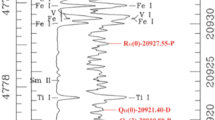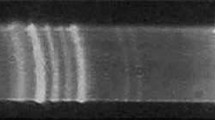Abstract
The \(B^{3}\Pi _{2} - X^{3}\Delta _{2}\) (0, 0) band system of the titanium monoxide (TiO) molecule was excited in a DC copper arc with a constant deviation spectrometer. The resulting spectrum has been analyzed using image J software. Relative intensity measurements of the P- and R-branch molecular lines of the (0, 0) band with rotational quantum (\(J\)) numbering have been obtained. The measured intensity of rotational molecular lines and the \(J\) numbering were used to estimate the excitation rotational temperature of the source emitting the spectrum of TiO molecules. Also the presence of TiO spectral lines of the \(B^{3}\Pi _{2} - X^{3}\Delta _{2}\) (0, 0) band in the wavenumber region of 14 500 to 16 000 cm−1 has been confirmed in the umbral spectrum, from the atlases recorded at the National Solar Observatory using the Fourier transform spectrometer (FTS) of the McMath-Pierce Solar Telescope on Kitt Peak. The combined laboratory and sunspot spectral line measurements have been used to obtain the improved molecular structure parameters for the electronic states \(B^{3}\Pi _{2}\) and \(X^{3}\Delta _{2}\) of the TiO molecule. Using equivalent width measurements of well resolved and identified lines in the sunspot spectrum with known rotational quantum number, the effective rotational temperature was found to be \(2555 \pm 780\) K. This proves the presence of TiO molecules in sunspot and other higher temperature astrophysical sources.






Similar content being viewed by others
References
Amiot, C., Azaroual, E.M., Luc, P., Vetter, R.: 1995, High resolution rotational analysis of the \(B^{3}\Pi -X ^{3}\Delta \) (1, 0) band of titanium monoxide. J. Chem. Phys. 102, 4375. DOI.
Barnbaum, C., Omont, A., Morris, M.: 1996, The unusual circumstellar environment of the evolved star, U Equulei. Astron. Astrophys. 310, 259. ADS.
Bauschlicher, C.W., Ram, R.S., Bernath, P.F., Parsons, C.G., Galehouse, D.: 2001, The \(A ^{6}\Sigma ^{+}-X ^{6}\Sigma ^{+}\) transition of CrH, Einstein coefficients, and an improved description of the A state. J. Chem. Phys. 115(3), 1312. DOI.
Bruggeman, P.J., Sadeghi, N., Schram, D.C., Lins, V.: 2014, Gas temperature determination from rotational lines in non-equilibrium plasmas: a review. Plasma Sources Sci. Technol. 23(2), 023001. DOI.
Engvold, O.: 1973, A high dispersion spectrum 6610 Å to 6770 Å of a large sunspot. Astron. Astrophys. Suppl. 10, 11. ADS.
Fawzy, D.: 2009, The rotational temperature of the FeH molecules in a large sunspot. New Astron. 14, 708. DOI.
Fletcher, D.A., Scurlock, C.T., Jung, K.Y., Steimle, T.C.: 1993, Hyperfine interactions in the ground states of titanium monoxide and mononitride. J. Chem. Phys. 99, 4288. DOI.
Hartmann, J.: 1898, A simple interpolation formula for the prismatic spectrum. Astrophys. J. 8, 218. DOI.
Herzberg, G.: 1950, Molecular Spectra and Molecular Structure I. Spectra of Diatomic Molecules, Van Nostrand, Toronto. ISBN: 9781443726085, 1443726087.
Huber, K.P., Herzberg, G.: 1979, Molecular Spectra and Molecular Structure. IV. Constants of Diatomic Molecules, Van Nostrand/Reinhold Company, New York. ISBN: 0-442-23394-9.
Kirkpatrick, J.D., Henry, T.J., McCarthy, D.W.: 1991, A standard stellar spectral sequence in the red/near-infrared: classes K5 to M9. Astrophys. J. Suppl. 77, 417. DOI.
Konwar, M., Brauah, G.D.: 2010, Special issue. Asian J. Spectrosc. 153. http://imagej.nih.gov/ij.
Lambert, D.L., Mallia, E.A.: 1972, The (0, 0) band of the gamma-system of TiO in the umbral spectrum: the isotopic abundances of Ti. Mon. Not. Roy. Astron. Soc. 156, 337. DOI.
Makita, M.: 1968, A study of the green TiO band in the sunspot spectrum. Solar Phys. 3, 557. DOI.
McKemmish, L.K., Masseron, T., Sheppard, S., Sandeman, E., Schofield, Z., Furtenbacher, T., Császár, A.G., Tennyson, J., Sousa-Silva, C.: 2017, Marvel analysis of the measured high-resolution rovibronic spectra of TiO. Astrophys. J. Suppl. Ser. 228, 15. https:/doi.org/10.3847/1538-4365/228/2/15.
Mulchaey, J.S.: 1989, The rotational temperature of the FeH molecule in a sunspot. Publ. Astron. Soc. Pac. 101, 211. DOI.
Phillips, J.G.: 1973, Molecular constants of the TiO molecule. Astrophys J Supp. Series 26, 313. DOI.
Ram, R.S., Bernath, P.F., Wallace, L.: 1996, Near-infrared spectroscopy of TiO: laboratory measurements and identification in sunspots. Astrophys. J. Suppl. Ser. 107, 443. DOI.
Ram, R.S., Bernath, P.F., Dulick, M., Wallace, L.: 1999, The \(A ^{3}\Phi-x ^{3}\Delta \) system (\(\gamma \) bands) of TiO: laboratory and sunspot measurements. Astrophys. J. Suppl. Ser. 122, 331. DOI.
Richardson, R.S.: 1931, An investigation of molecular spectra in sun-spots. Astrophys. J. 73, 216. DOI.
Sotirövski, P.: 1971, The molecular spectrum of sunspot umbrae. Astron. Astrophys. 14, 319. ADS.
Sotirövski, P.: 1972, Table of solar diatomic molecular lines spectral range 4900 - 6441 Å. Astron. Astrophys. Suppl. Ser. 6, 85. ADS.
Sriramachandran, P., Shanmugavel, R.: 2011, On the effective temperature of large sunspot umbra using CrH sextets electronic state molecular lines. Astrophys. Space Sci. 336, 379. DOI.
Sriramachandran, P., Shanmugavel, R.: 2013, Occurrence of AlO molecular lines in sunspot umbral spectra. Solar Phys. 286, 315. DOI.
Sriramachandran, P., Rajamanickam, N., Bagare, S.P., Balachandrakumar, K.: 2008, Presence of LaO, ScO and VO molecular lines in sunspot umbral spectra. Solar Phys. 252, 267. DOI.
Tylenda, R., Cravse, L.A., Gomy, S.K., Schmidt, M.R.: 2005, V4332 Sagittarii revisited. Astron. Astrophys. 439(2), 651. DOI.
Valenti, J.A., Piskunov, N., Johns-Krull, C.M.: 1998, Spectral synthesis of TiO lines. Astrophys. J. 498, 851. DOI.
Viswanathan, B., Shanmugavel, R., Bagare, S.P., Rajamanickam, N., Sriramachandran, P.: 2009, Identification of CrH and CrD molecular lines in the sunspot umbral spectrum. Solar Phys. 257, 261. DOI.
Wallace, L., Hinkle, K., Livingston, W.C.: 2000, An atlas of sunspot umbral spectra in the visible from 15,000 to 25,000 cm−1 (3920 to 6664 Å). Tec. Rep. 00-001, NSO, Tucson.
Wallace, L., Livingston, W.C., Bernath, P.F., Ram, R.S.: 1998, An atlas of the sunspot umbral spectrum in the red and infrared from 8900 to 15 050. cm−1 (6642 to 11230 Å). Tech. Rep. 98-001. NSO, Tucson.
Weber, J.C.: 1971, The molecular spectrum of sunspots. Solar Phys. 16, 340. DOI.
Wöhl, H.: 1971, On molecules in sunspots. Solar Phys. 16, 362. DOI.
Acknowledgements
The authors express deep gratitude to their mentors and Prof. S. P. Bagare, Indian Institute of Astrophysics, Bangalore, and Dr. N. Rajamanickam, Former Head, Physics Research Centre, VHNSN College, Virudhunagar. The solar atlases used in this study are taken from the technical reports of the National Solar Observatory web site, operated by the Association of Universities in Astronomy, Inc. (AURA), under a cooperative agreement with the National Science Foundation.
Author information
Authors and Affiliations
Corresponding author
Ethics declarations
Disclosure of Potential Conflicts of Interest
The authors declare that they have no conflict of interest.
Additional information
Publisher’s Note
Springer Nature remains neutral with regard to jurisdictional claims in published maps and institutional affiliations.
Rights and permissions
About this article
Cite this article
Sriramachandran, P., Priyadharshini, D., Ashraf Shiddeeqaa, N. et al. An Analysis of the \(B^{3}\Pi _{2} - X^{3}\Delta _{2}\) (0, 0) Band System of the TiO Molecule in Laboratory and Sunspot Spectra. Sol Phys 295, 169 (2020). https://doi.org/10.1007/s11207-020-01737-6
Received:
Accepted:
Published:
DOI: https://doi.org/10.1007/s11207-020-01737-6




